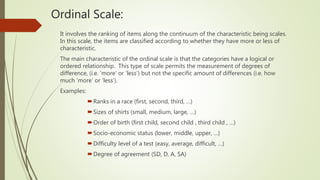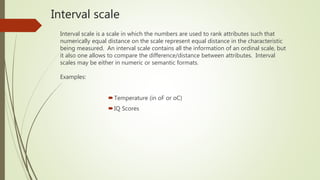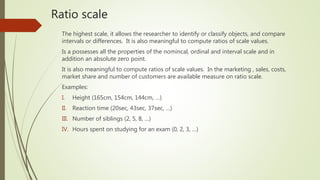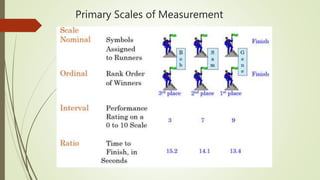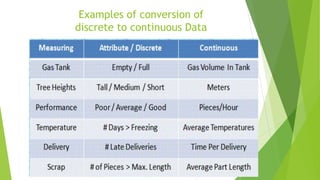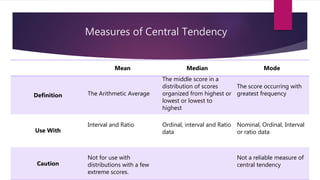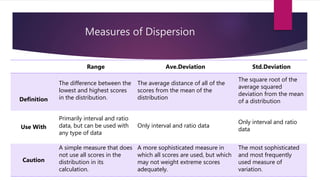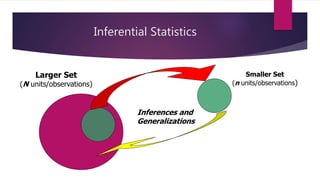Basic statistics
- 2. What is Statistics? “Statistics is concerned with the inferential process, in particular with planning and analysis of experiments or surveys, with the nature of observational errors and sources of variability that obscure underlying patters, and with efficient summarizing of set of data” = Kruskal Why should we use statistics? Statistical methods are required to ensure that data are interpreted correctly and the apparent relationship are meaningful and not simply chance occurrence. Statistics in Different Field 1. Business 2. Economics 3. Banking 4. Accounts and Auditing etc., Every day example… 1. Weather forecast 2. Emergency preparedness 3. Predicting diseases 4. Medical study 5. Political campaigns etc.,
- 3. Types of Data Qualitative Quantitative Discrete Continuous
- 4. • Qualitative Data Qualitative data can be arranged into categories that are non numerical. These categories can be physical traits, gender, colors or anything that does not have a number associated to it. Qualitative data is sometimes referred to as categorical data •Examples: •Hair color (black, brown, blonde, white, grey, mahogany) •Make of car (Dodge, Honda, Ford, Toyota) •Gender (male, female) •Place of birth (Riyadh, Jeddah, Yanbu)
- 5. • Quantitative Data Quantitative data are measures of values or counts and are expressed in numeric variables. Examples: For each orange tree, the number of oranges is measured For a particular day, the number of cars entering a college campus is measured Time until a light bulb burns out Etc.,
- 6. Four Basic Scale of Measurement
- 7. Nominal Scale: This scale is the crudest among all measurement scales but is also the simplest scale. In this scale the different scores on a measurement simply indicate different categories. The nominal scale is often referred to as a categorical scale. The assigned numbers have no arithmetic properties and act only as labels. The only statistical operation that can be performed on nominal scales is a frequency count. We cannot determine an average except mode. Examples: Gender (1= male, 0=female) ZIP code (7000=Philippines, …) Plate numbers of vehicles (JK3429, MC001, …) Course (Biology, Mathematics, History, …) Race (Asian, American, …) Eye color (Brown, Blue, …)
- 8. Ordinal Scale: It involves the ranking of items along the continuum of the characteristic being scales. In this scale, the items are classified according to whether they have more or less of characteristic. The main characteristic of the ordinal scale is that the categories have a logical or ordered relationship. This type of scale permits the measurement of degrees of difference, (i.e. 'more’ or ‘less’) but not the specific amount of differences (i.e. how much ‘more’ or ‘less’). Examples: Ranks in a race (first, second, third, …) Sizes of shirts (small, medium, large, …) Order of birth (first child, second child , third child , …) Socio-economic status (lower, middle, upper, …) Difficulty level of a test (easy, average, difficult, …) Degree of agreement (SD, D, A, SA)
- 9. Interval scale Interval scale is a scale in which the numbers are used to rank attributes such that numerically equal distance on the scale represent equal distance in the characteristic being measured. An interval scale contains all the information of an ordinal scale, but it also one allows to compare the difference/distance between attributes. Interval scales may be either in numeric or semantic formats. Examples: Temperature (in oF or oC) IQ Scores
- 10. Ratio scale The highest scale, it allows the researcher to identify or classify objects, and compare intervals or differences. It is also meaningful to compute ratios of scale values. Is a possesses all the properties of the nomincal, ordinal and interval scale and in addition an absolute zero point. It is also meaningful to compute ratios of scale values. In the marketing , sales, costs, market share and number of customers are available measure on ratio scale. Examples: I. Height (165cm, 154cm, 144cm, …) II. Reaction time (20sec, 43sec, 37sec, …) III. Number of siblings (2, 5, 8, …) IV. Hours spent on studying for an exam (0, 2, 3, …)
- 11. Primary Scales of Measurement
- 12. Discrete and Continuous Data Numerical data could be either discrete or continuous. Continuous data can take any numerical value (within a range); For example, weight, height, etc., There can be an infinite number of possible values in continuous data. Discrete data can take only certain values by a finite ;jumps;, i., it ‘jumps’ from one value to another but does not take any intermediate value between them (For example, umber of students in the class)
- 13. Example for Discrete and Continuous Data A good example to distinguish discrete data from continuous data is digital and analogue meter or clock were digital is discrete and analog is continuous.
- 14. Examples of conversion of discrete to continuous Data
- 15. Area of Statistics Descriptive statistical limits generalization to the particular group of individuals observed. That is: 1. No conclusions are extended beyond this group 2. Any similarity to those outside the group cannot be assumed. 3. The data describe one group and that group only. Example: Assessment findings, findings a much simpler action research. Inferential analysis selects a small group out of larger group an the findings are applied to the larger group. It is used to estimate a parameter, the corresponding value in the population from the which the sample is selected. It is necessary to carefully select the sample or the inferences may not apply to the population.
- 17. Measures of Central Tendency and Dispersion
- 18. Measures of Central Tendency Mean Median Mode Definition The Arithmetic Average The middle score in a distribution of scores organized from highest or lowest or lowest to highest The score occurring with greatest frequency Use With Interval and Ratio Ordinal, interval and Ratio data Nominal, Ordinal, Interval or ratio data Caution Not for use with distributions with a few extreme scores. Not a reliable measure of central tendency
- 19. Measures of Dispersion Range Ave.Deviation Std.Deviation Definition The difference between the lowest and highest scores in the distribution. The average distance of all of the scores from the mean of the distribution The square root of the average squared deviation from the mean of a distribution Use With Primarily interval and ratio data, but can be used with any type of data Only interval and ratio data Only interval and ratio data Caution A simple measure that does not use all scores in the distribution in its calculation. A more sophisticated measure in which all scores are used, but which may not weight extreme scores adequately. The most sophisticated and most frequently used measure of variation.
- 20. Inferential Statistics Inferences and Generalizations Smaller Set (n units/observations) Larger Set (N units/observations)








